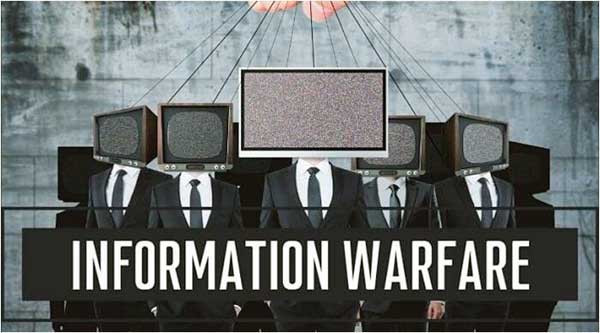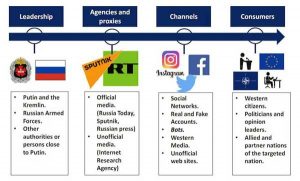“They lie in the office but beat them in the field” – Suvorov.
As a result of the ongoing war in Ukraine, one gets the impression that Russian, and even more so Soviet-styled, Information warfare is now losing not to NATO, but Ukraine. At the same time, even NATO acknowledges the might of the Russian military in Information operations based on recent experiences in Syria, Iran, and Armenia.
False flag operations are central to the deep fake ops; war in Ukraine points to how fabricated events can provoke violence and create a cloak of legitimacy for military action.
Russian approach for the past decade has been to capture the “consciousness of the masses.”, but Putin’s friendly blitzkrieg has proved to have given Ukraine an unscrupulous advantage in Information operations during these 12 days. While no one can deny the capability and the competency of the Russian Army in hybrid warfare, one still wonders which side is winning the narrative battle.
Deepfakes technology as a force multiplier
Deepfake is a simulation of reality that is computer-generated with the application of artificial intelligence to replace one’s likeness. Deepfake allows a large swath of unhindered cyberspace that hostile actors can exploit without legal liability. Before the invasion, there were numerous reports of the Russian Army targeting Ukrainian commanders and men with deep fake graphics and videos, text, and images of Russian convoys as a pretext for an invasion.
For months Russians have flooded their cyberspace with military build-up videos on Tiktok and social media. Russians were very smart in projecting the Deepfake technology, from showing security council meetings, Putin dressing down his spy chief, to Russian units returning to base.
Deepfake is an effective tool in armed conflict. Recently, in a meeting of the Belarusian security council on 1st March, President Lukashenko spilled all the beans of Russia’s ‘special operation’- Navy landing on Odesa, land thrust on Mykolaiv, and voznesensk on national TV, but instead Kharkiv and Kherson was hit. Deepfake is a subset of psychological operations- Russians have time and again used this deceptive information warfare to manipulate imagery and audio data and effectively disseminate videos on social media to gain a strategic and tactical edge.
Ukrainians are also not far behind the story of ‘rebellious brave soldiers on snake island’ is an example of this. False flag operations are central to the deep fake ops; war in Ukraine points to how fabricated events can provoke violence and create a cloak of legitimacy for military action.
Information is the mainstay of Ukrainians in the fight against a much superior Russian Army, and OSINT(open-source intelligence) has been a piledriver in this war. From the start, Ukraine and NATO styled coalition pre-bunked the Russian objective of legitimizing the long-planned invasion as a liberation of Donbas and Luhansk. They preempted the institutional disinformation campaign from channels like RT and Sputnik to youtube and social media accounts.
OSINT documented the Russian military invasion in overall ways, from flight radars to Satellite imagery justifying Russia as an aggressor. OSINT enabled the world to see what Ukrainians wanted them to see, with hourly updates to the analysis of every step, making it a very transparent war.
Once the war began, Heroism has pivoted the Ukrainian response, Zeleknsky became the ‘man of the people.’
The Russians are also not far behind after initial setbacks using the doctrine of maskirovka- bombing runs of Su-25s, Kadyrov’s men marching towards Kyiv, are a few examples. OSINT is a proven double-edged sword- When PLA ingressed into Eastern Ladakh, they purposely used OSINT(Satellite imagery) to dismay the Indian public.
Ingenious Ukrainian response
Once the war began, Heroism has pivoted the Ukrainian response, Zeleknsky became the ‘man of the people.’ He went into the conflict with -34 favourability amid general distrust but has become a global icon now. He has been successful in keeping his house in order and at the same time reaching a wider audience in countries like South Korea, Australia, and Japan.
From impending nuclear catastrophe to the use of Polish airspace for Ukrainian jets, this war has seen better and faster narratives by the Ukrainians than the Russians. Ukrainian has utilized abandoned/ destroyed old soviet fossils (Tanks and BTRs) and equipment like cluster munitions laying on the ground in DPR and LPR region for disinformation.
Apps like Twitter and Telegram are bombarding with updates like Another Russian tank down, and “occupiers” abandoned their equipment and fled to give an impression that Ukraine is fighting a David and Goliath battle. While information operation is a crucial part of any warfare strategy, it is seminal not to get carried away with one’s information campaign, something that- Armenia, Ghani, and PLA can substantiate.
Western media and TV channels have constantly attacked the Russian defense ministry’s claim and helped Ukraine in its psychological and information warfare intended to create a general disliking of the Russian invasion.
Societal isolation
Russians have been very cautious in using the terms ‘war’ and ‘invasion’ instead used Orwellian framing to give credibility to its political objectives of war. Western media and TV channels have constantly attacked the Russian defense ministry’s claim and helped Ukraine in its psychological and information warfare intended to create a general disliking of the Russian invasion.
As a result, War in Europe has drastically impacted companies operating in Russia- Netflix to Puma all are limiting or suspending their operations in Russia, triggering global isolation.
Today, Russian society is also facing the brunt of this crisis. Russia needs to mend ways with the west somewhere down the line to avoid isolation from companies like Microsoft, Google, Adobe, Nike, and Gucci that can trigger massive discontent among the Russian population that undo the political and strategical victory achieved in Ukraine.
Information Operation in India
Two realities and narratives are unfolding in India. First, India’s pragmatic stance of catering for its self-interests before jumping into the bandwagon of democracies, and Second, the old Cold War-type ‘psy-war’ is back in India. Given the lacking of investment Indian media makes in shaping the Indian perspective, it is gobbling up both Russian and Western information/disinformation.
While western outlets are questioning India’s abstention, Russians are busy giving history lessons on the 1971 war. Chinese are also not far behind in sowing confusion among QUAD nations.
In this age of social media, it is crucial to find the right message and the right messenger- the right messenger – something that Ukrainians have perfected in this war,
While Indians are questioning US’s reliability in standing up to the adversary, UK MPs are busy complaining against India’s informed neutrality in this conflict. Only time will tell where this conflict will lead Indian narrative.US experts have pointed out that New Delhi is walking on thin ice, maybe and maybe not!!
Conclusion
With every conflict, a new trend emerges in warfare. In Nagorno-Karabakh, we saw disruptive drone technology. Afghanistan was an example of how low morale cannot compensate for better equipment and tactical edge. Ukraine’s invasion is a testament to effective information warfare.
In this age of social media, it is crucial to find the right message and the right messenger- the right messenger – something that Ukrainians have perfected in this war, many thanks to NATO’s unrelenting support.






